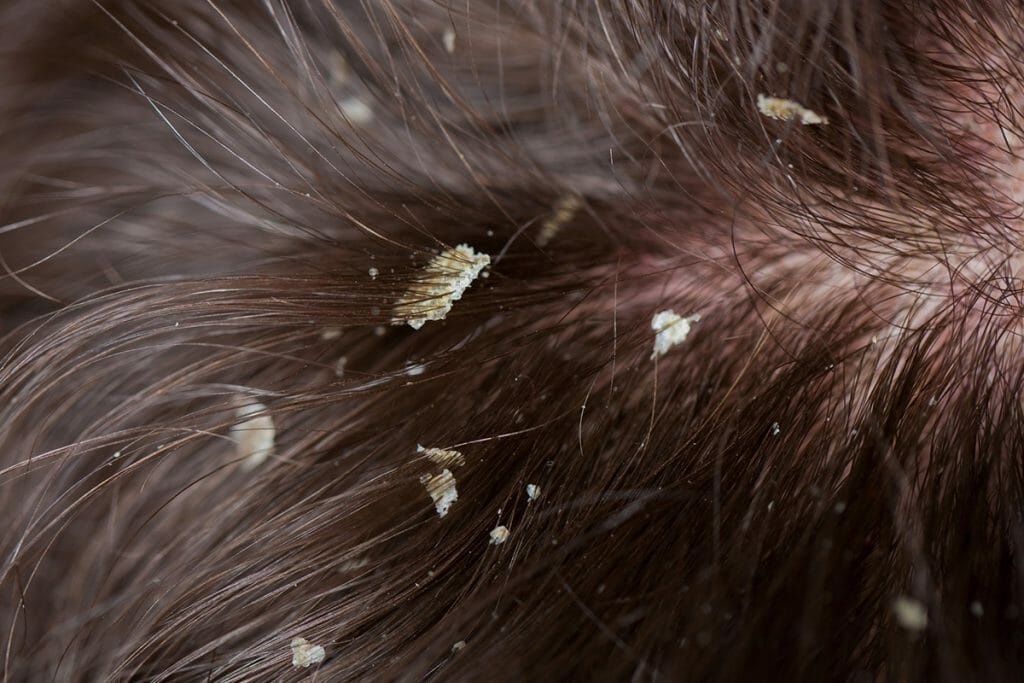A lot of us are partial to a bit of snow, but we think it’s safe to say, it tends to be considerably more enjoyable when it’s falling from the sky, not from your scalp. Dandruff affects around 50% of the population, some worse than others, so if you’re suffering from a snowy forecast, you’re certainly not alone.
What is dandruff?
To keep itself healthy, our skin is constantly shedding old cells in order to make way for new ones. The problem is, sometimes the skin gets a little bit ahead of itself, causing patches of dead cells to form on the scalp and flake away into the hair. Hello, dandruff.

Do bear in mind though that there is a difference between dandruff, and having a dry scalp. Dandruff flakes are greasy, usually a yellowish-white colour, and often get “stuck” to the scalp. Small “dusty” flakes, on the other hand, are likely a result of dry skin. It’s important to understand the difference here, as dandruff treatments are designed to target excess oil, so they’re likely to make a dry scalp worse. If you think your flakes are a result of a dry scalp, simply switching to a shampoo with a gentler formulation usually does the trick.
If you’re unsure, here are some quick tests you can try:
The day after washing your hair, give your scalp a firm massage with your fingers. If they end up with an oily residue, and you feel like you can “peel” flakes from your scalp, the chances are its dandruff.
Another test is to apply a light moisturiser to your scalp before you go to bed. If the flakes have disappeared the next morning then it’s likely that you’re dealing with a dry scalp.
What causes dandruff?
You might have heard that dandruff is caused by not washing your hair enough, or washing it too often. Whilst bad hair washing habits can certainly contribute to scalp irritation, it’s unlikely to be the root cause of the issue.
An underlying skin problem is more likely to blame. Seborrheic dermatitis is the most common cause of dandruff; its a condition associated with an overgrowth of yeast on the skin and is the same thing that causes cradle cap in babies.
A fungus called Malassezia is also a notable culprit. Malassezia is found on everyone’s head, but some people end up with too much of it, although scientists are still unsure as to why. This overgrowth leads to inflammation, itching, and those nasty oily flakes.
What’s the best way to get rid of dandruff?
Unfortunately, there is no outright cure for dandruff, but it can be controlled with specialist shampoos. As for the active ingredients used to treat the problem, you’ve got a bunch of different options:
- Salicylic Acid – This is used to exfoliate the skin, eliminating the flakiness. Just be careful as it can cause over-drying of the scalp, so it’s best to be used in conjunction with a moisturising conditioner.
- Coal Tar – This works by slowing down the skin renewal process.
- Zinc Pyrithione – An antibacterial and antifungal agent, great for combatting Malassezia.
- Selenium Sulfide – This also slows down the rate in which skin cells die off, and also helps to control levels of Malassezia.
- Tea Tree Oil – An extract of the Melaleuca Alternifolia Tree with natural antiseptic, antifungal and antibiotic properties.
- Ketoconazole – A broad-spectrum antifungal medication that is often successful when other treatments fail. It is available in both over the counter and prescription strength shampoo.
If you’re not too keen on the idea of loading your scalp with chemicals, there are also a couple of natural remedies you could try:
- Diluted Vinegar – Weekly treatment – You can use either Apple Cider Vinegar or plain White Vinegar. Mix half a cup of vinegar with half a cup of water, work into your scalp and give it a rinse with water (no shampoo). Leave your hair to its own devices overnight for at least 8 hours (wrap your hair in clingfilm to avoid vinegary pillows), then give it a wash with shampoo.
- Baking Soda – Daily treatment – Replace your usual shampoo with a baking soda solution. It acts as an exfoliator to remove dried dead skin, clean the scalp and reduce the levels of oil. Mix 1 tablespoon of baking soda with 1 cup of warm water, and work the paste into your hair and scalp.
Final thoughts
As annoying as dandruff can be, it’s pretty easy to keep at bay once you find a treatment that works for you. If you’ve tried an anti-dandruff shampoo for at least a month and things haven’t got any better, then it’s probably worth seeing your GP or a dermatologist. The same goes if your scalp is exceptionally itchy, red, or swollen.



